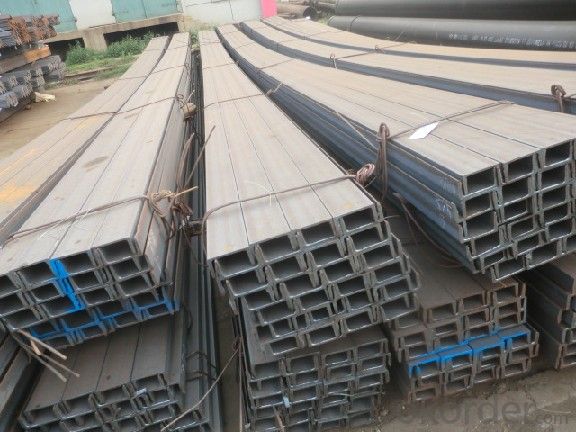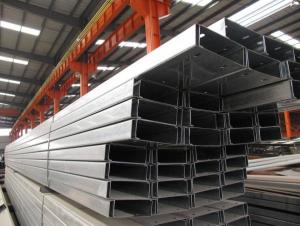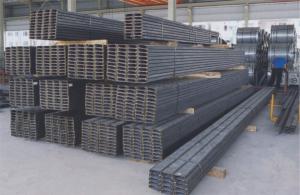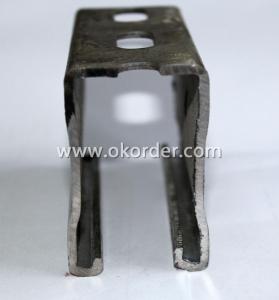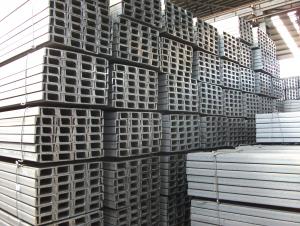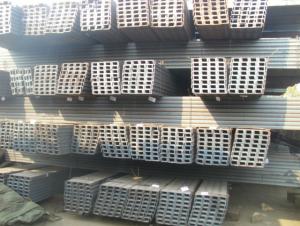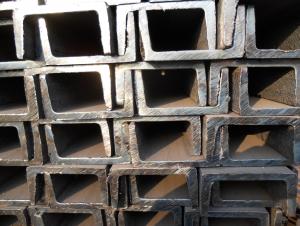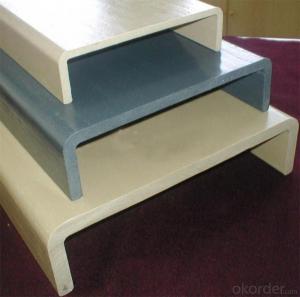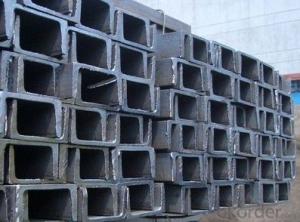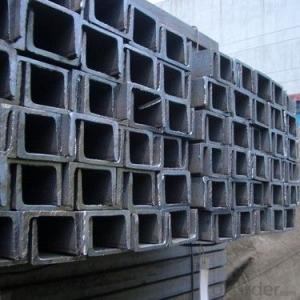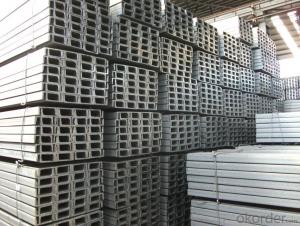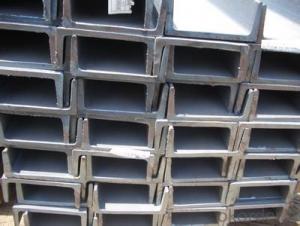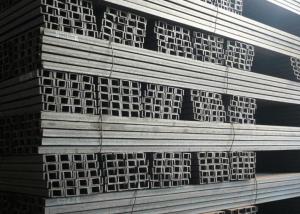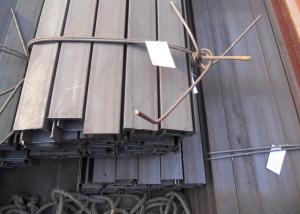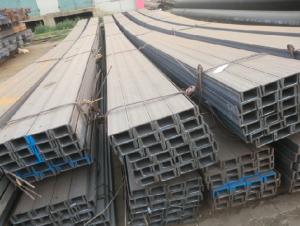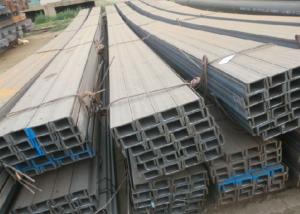JIS G3192 U Channel Steel high quality
- Loading Port:
- Tianjin
- Payment Terms:
- TT OR LC
- Min Order Qty:
- 25 m.t
- Supply Capability:
- 20000 m.t/month
OKorder Service Pledge
OKorder Financial Service
You Might Also Like
Product Description:
OKorder is offeringJIS G3192 U Channel Steel high qualitygreat prices with worldwide shipping. Our supplier is a world-class manufacturer of steel, with our products utilized the world over. OKorder annually supplies products to European, North American and Asian markets. We provide quotations within 24 hours of receiving an inquiry and guarantee competitive prices.
Product Applications:
JIS G3192 U Channel Steel high quality are ideal for structural applications and are widely used in the construction of buildings and bridges, and the manufacturing, petrochemical, and transportation industries.
Product Advantages:
OKorder's JIS G3192 U Channel Steel high qualityare durable, strong, and resist corrosion.
Main Product Features:
· Premium quality
· Prompt delivery & seaworthy packing (30 days after receiving deposit)
· Corrosion resistance
· Can be recycled and reused
· Mill test certification
· Professional Service
· Competitive pricing
Product Specifications:
Specifications of Steel U Channel:
Standard Applied: GB Standard, EN Standard(UPN), JIS Standard
Sizes: 50mm to 300mm
Material Grade: Q235B, Q345B, S235JR, SS400, ASTM A36
As shown in the figure:
JIS U CHANNEL | Standard h | Sectional b | Dimension s | t | Mass: Kg/m |
(mm) | (mm) | (mm) | (mm) | ||
50x25 | 50 | 25 | 3.0 | 6.00 | 2.37 |
75X40 | 75 | 40 | 3.8 | 7.00 | 5.30 |
75X40 | 75 | 40 | 4.0 | 7.00 | 5.60 |
75X40 | 75 | 40 | 4.5 | 7.00 | 5.85 |
75X40 | 75 | 40 | 5.0 | 7.00 | 6.92 |
100X50 | 100 | 50 | 3.8 | 6.00 | 7.30 |
100X50 | 100 | 50 | 4.2 | 6.00 | 8.03 |
100X50 | 100 | 50 | 4.5 | 7.50 | 8.97 |
100X50 | 100 | 50 | 5.0 | 7.50 | 9.36 |
125X65 | 125 | 65 | 5.2 | 6.80 | 11.66 |
125X65 | 125 | 65 | 5.3 | 6.80 | 12.17 |
125X65 | 125 | 65 | 5.5 | 8.00 | 12.91 |
125X65 | 125 | 65 | 6.0 | 8.00 | 13.40 |
150x75 | 150 | 75 | 5.5 | 7.30 | 14.66 |
150x75 | 150 | 75 | 5.7 | 10.00 | 16.71 |
150x75 | 150 | 75 | 6.0 | 10.00 | 17.90 |
150x75 | 150 | 75 | 6.5 | 10.00 | 18.60 |
Note: We are able to supply other dimensions and sizes, which depends on the customer's requirements for the quantity.
Chemical Composition of Q235B Steel U Channel:
Alloy No | Grade | Element(%) | ||||
C | Mn | S | P | Si | ||
Q235 | B | 0.12-0.20 | 0.3-0.7 | ≦0.045 | ≦0.045 | ≦0.3 |
Package & Delivery of JIS U Channel Steel:
1.The JIS u channel steel will be packed in bundle with steel wire at each end of every bundle and color marking in order to help the customer to recognize his goods more easily at sight.
2. And the channel steel could be loaded into 20ft or 40ft container, or by bulk cargo.If the weight of each bundle reaches more than 3.5 mt, the loading by break bulk cargo should be choosed.When the weight of each bundle reaches less than 3mt, the loading by container should be choosed.
3.As for the transportaion from mill to loading port, the truck will be usually used. And the maximum quantity for each truck is 40mt.
4.All in all, we could do in accordance with customer's request.
FAQ:
Q1: Why buy Materials & Equipment from OKorder.com?
A1: All products offered byOKorder.com are carefully selected from China's most reliable manufacturing enterprises. Through its ISO certifications, OKorder.com adheres to the highest standards and a commitment to supply chain safety and customer satisfaction.
Q2: Can fit in the containers of 20fts the steel beams of 6M?
A2: No proble, we can put them into the containers in the form sideling.
Q3: The products are invoicing on theoritical weight or on actual weight?
A3: We can do it in both manners, according to the customers' request.
Images:
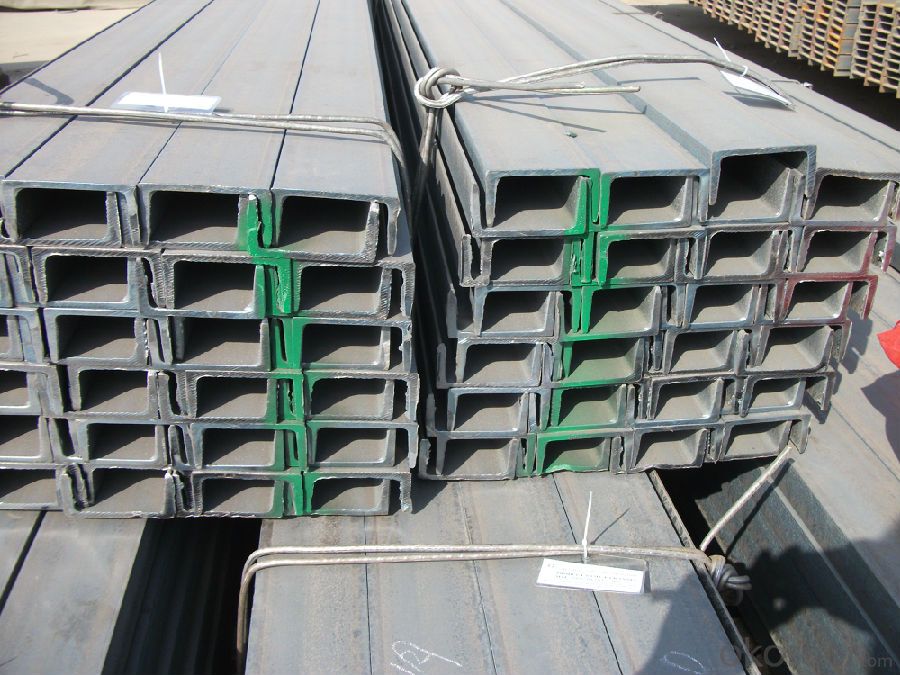
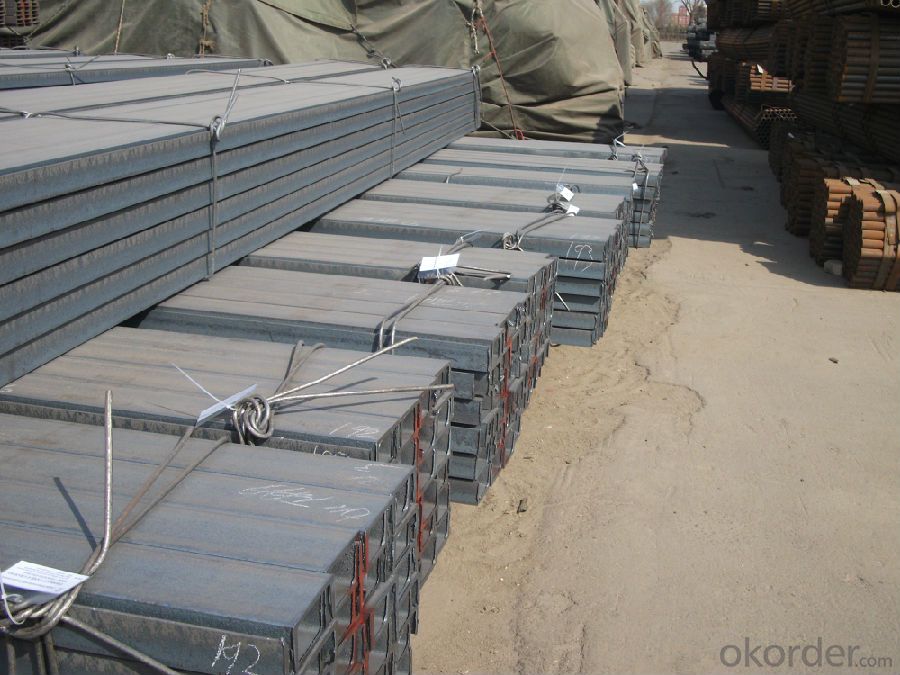
- Q: How do steel channels contribute to the stability of mezzanine floors?
- Steel channels are essential components in the construction of mezzanine floors and play a crucial role in contributing to their stability. These channels, also known as C-channels or C-sections, are made of high-strength steel and are specifically designed to provide structural support and reinforcement. One of the main ways steel channels contribute to the stability of mezzanine floors is by distributing the load evenly across the floor structure. Mezzanine floors are designed to accommodate heavy loads, such as machinery, equipment, or storage materials. The steel channels act as beams that bear the weight and transfer it to the vertical supports or columns. By distributing the load, they prevent localized stress concentration and ensure the overall stability of the floor. Furthermore, steel channels add rigidity to the mezzanine floor system. Due to their shape and structural properties, they offer excellent resistance to bending and torsion forces. This rigidity is crucial in preventing any excessive deflection or movement of the floor, especially when subjected to dynamic loads or vibrations. The stability provided by the steel channels enhances the safety and functionality of the mezzanine floor, allowing it to withstand heavy usage and ensure a secure work environment. Moreover, steel channels contribute to the overall durability and longevity of mezzanine floors. Steel is a highly durable material that can withstand a wide range of environmental conditions, such as temperature variations, moisture, and corrosion. By using steel channels, the structural integrity of the mezzanine floor system is enhanced, minimizing the risk of deformation, sagging, or structural failure over time. This durability ensures that the mezzanine floor can endure heavy loads for an extended period, reducing the need for frequent maintenance or replacement. In summary, steel channels play a vital role in contributing to the stability of mezzanine floors by distributing loads evenly, providing rigidity, and enhancing durability. Their structural properties ensure the safety, functionality, and longevity of mezzanine floors, making them an essential component in their construction.
- Q: What does "14 channel steel" do in the template "[14"?
- The template in the [14 representation is No. 14 channel (make an unnecessary move).
- Q: The reinforced welding off? Can the channel steel locked with expansion screws be taken out?
- Generally speaking, the welding place is stronger than the steel bar itself. If the tool class is concerned, an electric sand grinder is easy to handle. Manual, it is estimated to use a knife slowly.
- Q: Can steel channels be used in interior design applications?
- Yes, steel channels can definitely be used in interior design applications. They have a sleek and modern appearance that can add an industrial or contemporary touch to a space. Steel channels can be used as structural elements, decorative accents, or even as functional storage solutions. They are versatile, durable, and can be customized to fit various design styles.
- Q: Are steel channels suitable for railway infrastructure projects?
- Yes, steel channels are indeed suitable for railway infrastructure projects. Steel channels are commonly used in railway infrastructure projects due to their high strength and durability. They can support heavy loads and provide stability to the railway structure. Steel channels also have excellent resistance to corrosion and can withstand harsh weather conditions, making them ideal for outdoor applications. Additionally, steel channels can be easily fabricated and installed, which helps to expedite the construction process. Overall, the use of steel channels in railway infrastructure projects ensures the safety and longevity of the railway system.
- Q: Can steel channels be used for scaffolding?
- Indeed, scaffolding can utilize steel channels. Given their strength and durability, steel channels prove apt for bearing substantial loads and offering a steadfast surface for laborers. Additionally, their simple assembly and disassembly foster adaptability and adjustability within scaffolding frameworks. Furthermore, steel channels exhibit resistance to corrosion and endure inclement weather, thereby establishing themselves as a dependable option for outdoor scaffolding. All in all, steel channels furnish the essential robustness and stability indispensable for scaffolding, rendering them a frequently employed material within the construction sector.
- Q: What are the different types of loads that steel channels can bear?
- Steel channels exhibit versatility as structural components capable of bearing different types of loads. The array of loads they can endure includes: 1. Compression Load: With a high load-bearing capacity, steel channels can effectively withstand compression forces. They find common usage in columns and beams, providing support for the weight of structures and facilitating vertical load transfer. 2. Tension Load: Steel channels possess the capability to resist tension loads, effectively countering forces that aim to pull or stretch the material. This attribute renders them appropriate for applications such as trusses or suspension systems. 3. Shear Load: Steel channels exhibit resilience against shear forces, which arise when two parallel forces exert themselves in opposite directions. They frequently find application in structural systems, effectively counteracting the shearing effects of horizontal loads like wind or seismic forces. 4. Bending Load: Steel channels proficiently bear bending loads, which emerge when forces are applied perpendicularly to the channel's axis. They are often utilized as beams or lintels, providing support for loads positioned over openings like doors or windows. 5. Axial Load: Steel channels are designed specifically to withstand axial loads, which act along the channel's longitudinal axis. These loads can either be compressive or tensile and are typically encountered in columns or vertical members. 6. Lateral Load: Steel channels possess the ability to bear lateral loads, which exert themselves perpendicular to the channel's longitudinal axis. These loads commonly originate from wind, earthquakes, or other horizontal forces and are effectively countered by the structural system incorporating the channel. In conclusion, steel channels offer a versatile option for structural applications due to their capacity to bear various types of loads. Their strength, durability, and flexibility render them suitable for an extensive range of construction and engineering projects.
- Q: Are steel channels cost-effective?
- Indeed, steel channels are commonly regarded as a cost-effective option. Renowned for its durability, strength, and longevity, steel stands as a dependable substance for a multitude of construction and industrial purposes. The purpose of steel channels is to offer structural reinforcement, evenly distribute burdens, and improve steadiness in edifices and infrastructure ventures. Furthermore, steel channels are conveniently obtainable and can be effortlessly crafted to meet particular project specifications. Despite potentially higher initial expenses in comparison to alternative materials, the enduring advantages of steel, such as minimal upkeep requirements and resistance to corrosion, render it an economically sensible selection in the grand scheme of things.
- Q: Use two long five meters of 10# channel steel load-bearing frame, the maximum load is?
- Set a span of 4.8m, two 10#Q235 channel parallel, as the beam, the required load is concentrated load, the role in the middle of channel.
- Q: How do steel channels perform under seismic loads?
- Due to their inherent properties and design characteristics, steel channels have the ability to perform exceptionally well under seismic loads. These channels are commonly utilized as structural components in buildings and bridges to provide support and stability. When subjected to seismic loads, steel channels demonstrate remarkable strength and ductility, enabling them to withstand the dynamic forces produced by an earthquake. The high tensile strength of steel guarantees that the channels can withstand bending and distortion, while their ductility allows them to absorb and dissipate energy during seismic events. Additionally, the seismic performance of steel channels can be further improved through design and reinforcement. Engineers can integrate additional reinforcement, such as diagonal bracing or moment connections, to enhance the channels' resistance to seismic forces. These reinforcements effectively distribute the forces more evenly throughout the structure, minimizing the likelihood of localized damage or failure. Furthermore, steel channels offer various other advantages in seismic design. They are comparatively lightweight compared to alternative building materials, reducing the overall mass of the structure and consequently decreasing the seismic forces acting upon it. Additionally, steel channels are easily fabricated and installed, facilitating more efficient construction and potentially reducing downtime after an earthquake. In conclusion, steel channels are an exceptional choice for constructing earthquake-resistant structures. Their inherent strength, ductility, and design flexibility make them highly capable of withstanding seismic loads, ensuring the safety and stability of structures in areas prone to earthquakes.
Send your message to us
JIS G3192 U Channel Steel high quality
- Loading Port:
- Tianjin
- Payment Terms:
- TT OR LC
- Min Order Qty:
- 25 m.t
- Supply Capability:
- 20000 m.t/month
OKorder Service Pledge
OKorder Financial Service
Similar products
Hot products
Hot Searches
Related keywords





